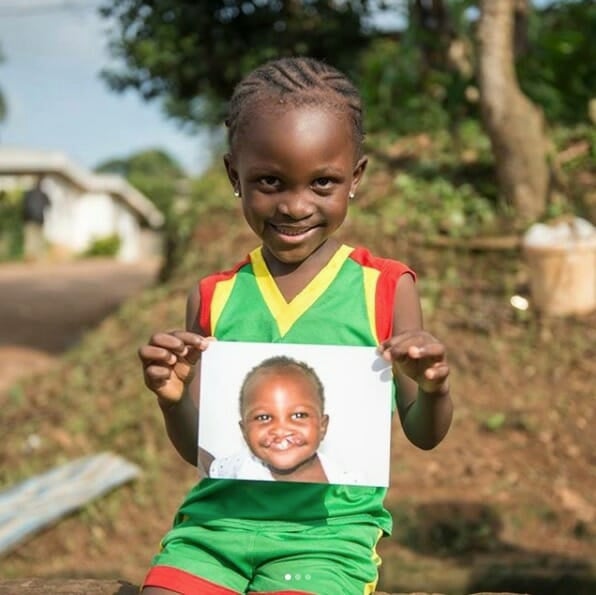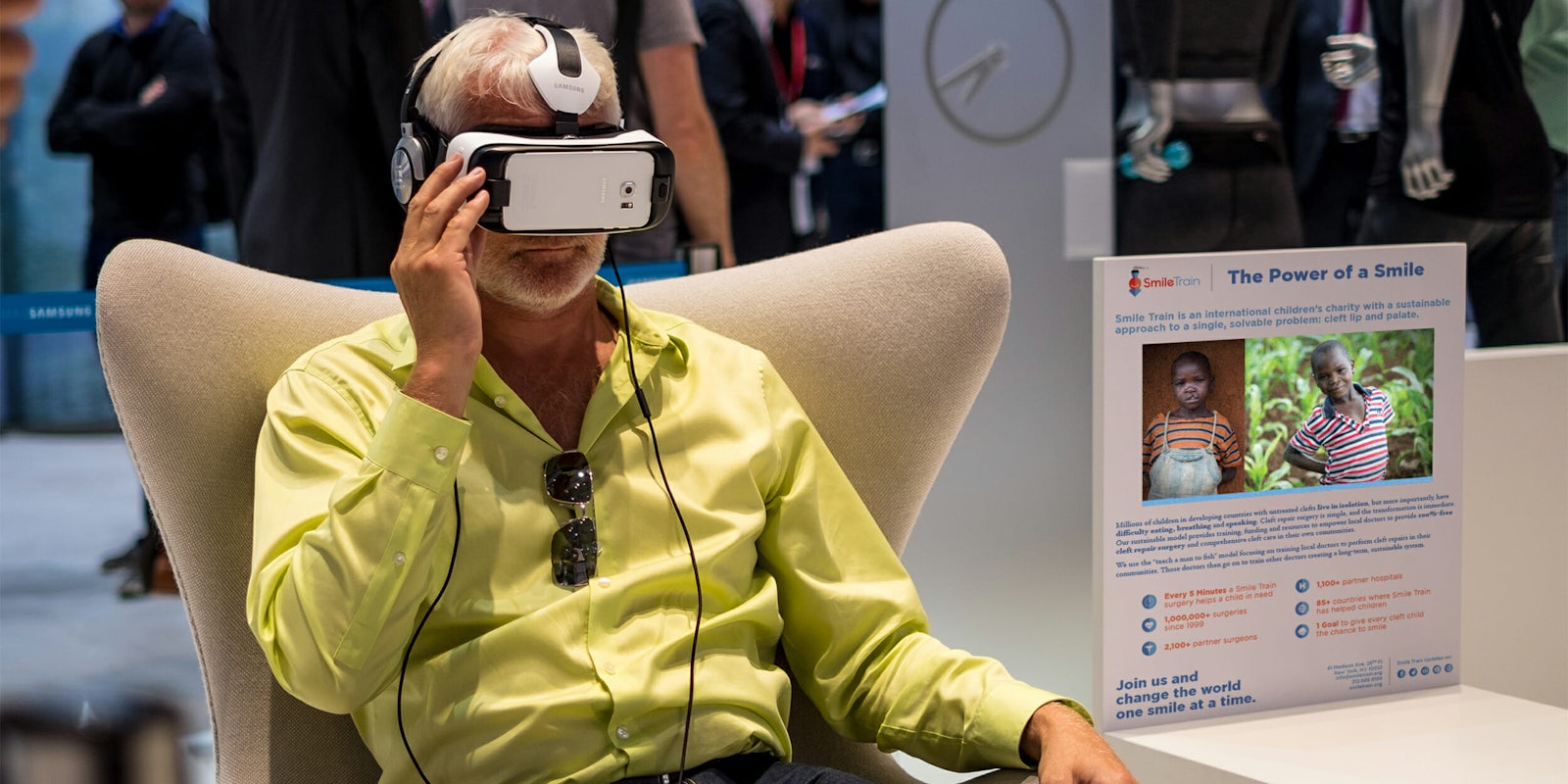I’m standing in the middle of a crumbling, sun-beaten neighborhood, peering out from my home as a trickle of villagers either cast disdainful glances in my direction or ignore me completely as they shamble through the derelict street. I feel isolated and alone, cut off from a dimmed world due to my cleft lip.
In the midst of my loneliness and resignation, a taxi takes me and my mother through bustling Indian roads to a faraway city, where I have the operation that sets my life on a new, exciting course. With my face now resembling my own dream of it, I begin going to school for the first time and mixing with children my own age, bringing me a confidence I wouldn’t have gained without the charity I was shown by Smile Train.
This, I’m fortunate enough to say, isn’t my own personal experience. However, for a moment—as I wear Smile Train’s cardboard VR goggles and watch two 360-degree videos the New York-based charity has produced—I’m given a surprisingly intimate sense of what it must feel like to live with a facial disfigurement, one that alienates you from your own community.
VR videos have an unprecedented power to communicate personal experiences, and a steadily growing number of charities such as Smile Train are turning to them to drive engagement and donations. Most famously, in 2015, the U.N. released Clouds Over Sidra, a 360-degree VR film that put viewers in the shoes of a 12-year-old Syrian refugee as she went about her “normal”day-to-day life in a Jordanian refugee camp. Not only did it give viewers a first-person experience of the hardships and dislocations of refugee life, but it helped the U.N. beat its $2.3 billion target for the Humanitarian Pledging Conference for Syria by a whopping 65 percent. Ever since this early success, an expanding number of charities, non-governmental organizations (NGOs), and nonprofits have been following in the U.N.’s wake. One of the most recent is the aforementioned Smile Train, a charity that funds and supports the provision of corrective surgery for children born with cleft lips or palates.
The charity’s VR videos serve to immerse viewers in the journey of two Indian children as they go from having untreated cleft lips to receiving cosmetic surgery. They both begin in the children’s villages: hot, desiccated expanses of sand and stone that emphasize the circular link between deprivation and the children’s facial defects. With the cardboard VR goggles strapped on, you literally look around and see the narrow world Nisha and Vikas inhabit staring back at you, filled with uninviting glances and dried-out buildings. Yet as both videos progress, their journeys over land and sea, and the piano-based music, usher in an expanding current of hope. At the end of Nisha’s video, this tentative hope turns into genuine joy when you turn around and see her family and neighbors smiling at her own, newly acquired smile.

One of the central aims of Smile Train’s VR videos was to produce just this kind of strong emotional reaction in its public. “Our story is a very emotional story,” CEO Susannah Schaefer explains. “When you think of the life that a child … who went with a cleft that was untreated for so long … there’s a lot of emotion in that.”
But on the other hand, Schaefer notes that Smile Train’s videos are simply an attempt to directly illustrate the work it does in over 85 nations. “Not everyone gets to visit the developing world and see how their funds are being put to use,” Schaefer says.
While Schaefer admits that it’s still too early to tell how the VR videos have contributed year-end giving, she reports that they’ve been “extremely well-received” at the various events, conferences, and fundraisers they’ve appeared at. Likewise, Greenpeace has reported promising early results from its two VR videos released in spring 2017, which depict the toll of global warming in the Arctic and the Amazon, and the World Wildlife Fund witnessed a 50 percent increase in people signing up to become donors after it rolled out a VR video as part of its ongoing Tiger Experience campaign.
There’s a good chance that such upticks in engagement might have something to do with the novelty and wow-factor of VR, but there’s a growing body of research suggesting that VR really does have the ability to increase empathy. ” In psychology, there is a literature on ‘perspective taking,'” says Jeremy Bailenson, a professor of communication at Stanford University. “My lab’s research has focused on comparing immersive virtual reality to other perspective taking techniques, for example, watching videos or imagining via role-playing. In general, our findings across over a dozen experiments since 2003 demonstrate that VR tends to produce more empathy than control conditions.”
For most people, the natural response to increased empathy is usually to do something to relieve it, which in the context of charities would be making a donation. “One finding which is fairly robust concerns the difference between attitudes and behaviors,” Bailenson elaborates. “VR tends to produce more behavior change than other types of perspective taking, while the differences in self-reported attitude changes are often similar across techniques.” In other words, people may not report or think they’ve been affected any more by a VR video than by a normal video or by a newspaper ad, yet their actual behavior following exposure to VR reveals an increased readiness to act helpfully towards the object(s) of their experiences.
It’s this kind of behavior-modifying process that accounts for VR’s seemingly tantalizing potential in the charity/NGO sector, with the likes of UNICEF, WaterAid, Conservation International, the (U.K.) National Autistic Society, and Alzheimer’s Research UK all jumping on the VR bandwagon in the past year or so. Yet the question is, despite the early hype, does virtual reality really have the power to be a game-changer for the not-for-profit sector?
The answer is probably no.
Before they could even reach the point of getting someone to watch a VR video, charities will still have to go through the same drawn-out process of distinguishing themselves via branding, running ads in more traditional media, and performing outreach at events and on location. That means the public will ultimately pick good causes the same way they’ve largely done in the past: according to their personal affinities and viewpoints.
And harnessing VR won’t be a straightforward matter for charities. It’s not enough for an NGO simply to produce any old video in 360 degrees. Instead, it will require charities to learn just what content exactly is most effective in conveying emotion via VR and to produce their videos accordingly. As Stanford’s Bailenson admits, “VR is a medium, just like the video or the written word.” As such, it has its own conventions and rules, which for now demand that videos are situated at a personal level and are given a strong narrative, so as to incite maximum empathy. Bailenson goes even further in de-romanticizing VR, adding, “We [the Virtual Human Interaction Lab at Stanford] would never blindly state that videos magically produce empathy,” he says. “The key is in the experience itself.”
This is a warning that all VR producers and charities should heed carefully. As Mark Zuckerberg taught the world only too well in October—when, as a cartoon avatar, he toured hurricane-ravaged Puerto Rico in a Facebook VR demo—it is possible to create a counterproductive virtual reality experience. And Facebook isn’t the only example of recent, ham-fisted attempts at “raising awareness” via VR. In June, there was an “instantaneous backlash” when the Australian St Vincent de Paul Society organized a virtual “sleepout,” with hundreds of CEOs using VR to comfortably simulate the experience of homelessness.
Such PR nightmares show that VR apps can’t be wielded indiscriminately. What’s more, there are many social causes that may not lend themselves to a VR experience. “Our story is a very emotional one, and it’s very visual,” Smile Train’s Susannah Schaefer says, “and so using VR for us makes great sense. I can’t say that would be the case for all charities, given what their missions are.”
To some degree, Schaefer’s suspicions are backed up research. For example, a 2015 study by social scientists at Carnegie Mellon University found that people are more likely to help others and give to charity when there are identifiable human beneficiaries. And from another angle, they’re backed up by research from Jeremy Bailenson, who found in two experiments that VR didn’t increase empathy for the elderly in people who were “ostracized” by an older person during a virtual game dubbed “cyberball.” While such research hasn’t been greatly replicated and expanded upon, it suggests that using VR to solve problems involving direct conflict might not be a viable strategy.
While VR might not be open to every kind of charity or NGO, its early performances suggest it will boost donation levels for some, and Smile Train confirms it “want[s] to use [virtual reality] more in the future.”
I left my own experience of Smile Train’s 360 videos feeling more moved than expected by the stories of its young protagonists. I not only saw but felt what it’s like to live with a debilitating condition more vividly than I’d ever seen or felt it via any other medium, and in the end, I realized that, if only more charities like Smile Train could get people to try out their VR media, there would be more of us willing to donate to them.
